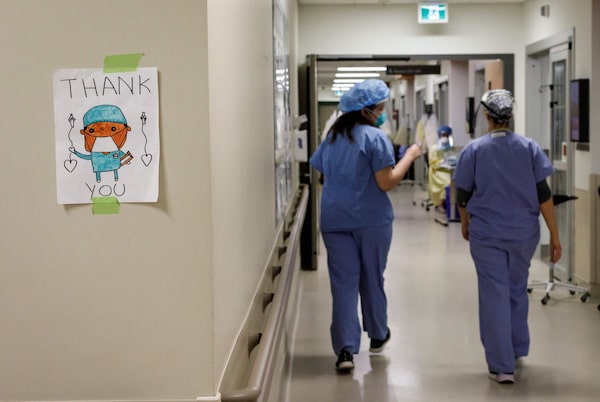
Healthcare workers walk through the hallway as staff care for patients suffering from COVID-19 at Humber River Hospital's Intensive Care Unit, in Toronto, on April 28, 2021.COLE BURSTON/AFP/Getty Images
David Jones is a policy analyst and economist. He is studying public policy at the Munk School of Global Affairs & Public Policy, University of Toronto.
Lengthy waiting lists, millions of citizens without access to primary care, gaping work force shortages and emergency departments closing. If the Canadian health care system were a patient, it would be in intensive care.
But despite these critical issues, Canada’s greatest health care challenge is the future, not the present.
Health care costs have been consuming a growing share of GDP in countries within the Organization for Economic Co-operation and Development (OECD). The OECD average has risen steadily from around 6 per cent in 1980 to 9.6 per cent in 2021. Demographics will exacerbate this trend: Canada’s population is aging quickly and the average health care costs of citizens aged over 65 are more than four times the adult average. Universal health care is an economic victim of its own success: It helps individuals to live longer, but they then require even more care in old age, thus generating a vicious cost spiral.
Technological developments also raise costs. Take Car-T cell therapy, a recent development in personalized cancer care, in which genetic refinements are made to strengthen a patient’s cancer-fighting cells. The treatment has been life-saving for some patients in trials, both in Canada and internationally. The financial cost of such treatments is extremely high though, estimated to be upward of $500,000 a patient in Canada.
The looming growth in health care costs bears resemblance to the current climate crisis. The warning lights have been flashing for some time, but corrective actions are slow.
For health care, reforms have also been stifled: A combination of the status quo being propped up by funding injections, critical short-term challenges distracting reform efforts, a general public tolerance of health care deficiencies and disagreements on optimal mitigation strategies. However, as recent analysis from the C.D. Howe Institute concludes, not only is public tolerance wearing thin, but a general consensus is forming around the necessary reforms, which offers a decisive opportunity for intervention.
We cannot continue as we are. It would be unwise for health care spending to grow so much as to further squeeze out other essential public services such as education and green investments. Higher income taxes or a long-term care insurance model could raise funds, but may not be politically acceptable, particularly given Pierre Poilievre’s ascendancy in the polls.
Rather we will have to make better use of the funding we have.
First, governments must make health care transformation a priority, allowing providers to allocate time and funding to innovation, even at some cost in the short-term. For example, the vast majority of family doctors report being overwhelmed by administrative tasks. Artificial intelligence, such as automated patient note-taking, can reduce costs while freeing staff to focus on their patients.
Although these are certainly “win-win” investments, new working patterns take time to embed, so governments must publicly protect providers during the transition period. In Toronto, the Humber River Hospital has a data command centre that has enabled a reduction in patient wait times, but this centre required more than a decade of careful planning and design.
Second, governments and citizens must work together to moderate health care demand. Given the cost-effectiveness of prevention, we must use the full tool kit to encourage and nudge citizens to better take care of themselves.
Private insurance companies already offer rewards when people exercise regularly; sugar taxes can rise further, pollution charges (such as the Ultra Low Emission Zone in London) should be installed; media campaigns are needed so citizens understand and appreciate the benefits of healthier living, and primary care access gaps must be solved to prevent minor conditions from becoming major.
Some progress is being made: In Britain, around half a million people can now monitor themselves (and send data to hospitals) remotely from their home via technology.
But as with the climate crisis, realism about our current state is also required.
Owing to the forecast demographic pressures, it will take a miracle for services to keep up with demand if we keep going as we are. Without transformational reform there will be tough conversations around higher taxes, trimming other public services, higher government borrowing or even suggestions of user fees and constraints on what governments can afford.
The warning lights are flashing. If we don’t act soon, we’ll look back and wonder just how good things used to be.